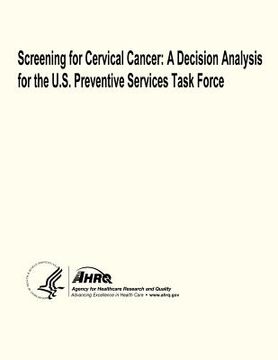Screening for Cervical Cancer: A Decision Analysis for the U.S. Preventive Services Task Force (en Inglés)
Reseña del libro "Screening for Cervical Cancer: A Decision Analysis for the U.S. Preventive Services Task Force (en Inglés)"
Worldwide, carcinoma of the cervix is one of the most common malignancies in women. In the U.S. in 2010, approximately 12,200 women were expected to be diagnosed with cervical cancer, and 4,210 women were expected to die. Assuming no change in risk, approximately 0.68% of women born today will be diagnosed with cervical cancer at some time during their lifetime, and the risk of dying from the disease is 0.24%. The incidence of cervical cancer and associated mortality have both decreased by over 40% since 1973. These declines are largely attributable to the success of mass screening using the Papanicolaou (Pap) cytology test to diagnose premalignant or early-stage disease. The decrease in invasive cervical cancer incidence and mortality since the introduction of this test has been so dramatic that it is one of the few interventions to receive an "A" recommendation from the U.S. Preventive Services Task Force (USPSTF). Despite the impact of cytology-based screening, there is still uncertainty about the details of cytology test performance, with specific concerns surrounding the poor sensitivity of cytology for detection of cervical intraepithelial neoplasia (CIN) grades 2 and 3. Efforts to improve cytology test performance have focused on reducing the number of false-negative smears; that is, cases in which premalignant or malignant cells are not diagnosed either because of sampling error (failure to place abnormal cells on the slide) or detection error (abnormal cells are misdiagnosed as normal). The human papillomavirus (HPV) deoxyribonucleic acid (DNA) test is currently recommended for use in cervical cancer screening. In the U.S., peak incidence and prevalence of HPV infection occur among women younger than age 25 years, but most infections in younger women are transient. HPV infections in older women are much less prevalent, but may carry a higher risk of progression to cervical neoplasia. As such, the American Cancer Society currently recommends that HPV testing be limited to women aged 30 years and older as part of a strategy of combination screening with cytology. In its previous recommendations, the USPSTF concluded that the evidence was insufficient to recommend for or against the routine use of HPV testing as a screening test for cervical cancer, although the U.S. Food and Drug Administration approved the use of HPV DNA testing for triage of atypical squamous cells of undetermined significance (ASC-US) or in conjunction with cytology for women aged 30 years or older. Quantifying the harms and benefits of HPV testing in order to inform any changes to the existing recommendations is one focus of this report. For the purposes of this report, HPV testing refers to use of the HC2 test only. Other questions addressed in this report include the optimal ages at which to begin and end screening, as well as the interval at which screening should be conducted. Currently, the USPSTF recommends that women begin screening within 3 years of onset of sexual activity or at age 21 years (whichever comes first), and that screening be conducted at least every 3 years. In terms of the age at which to end screening, the USPSTF recommendation states that screening should not be routinely recommended for women aged 65 years or older who have a history of normal Pap tests and are not otherwise at high risk for cervical cancer. Despite these recommendations, the summary states that direct evidence to estimate the optimal starting and stopping age and interval for screening is limited. This report summarizes the results from a decision analysis conducted using a previously developed and validated cervical cancer decision model. The Duke Cervical Cancer model was originally developed as part of a review of new screening technologies for the Agency for Healthcare Research and Quality. The model has been used to estimate the effectiveness of new screening technologies in a number of different settings and populations.

